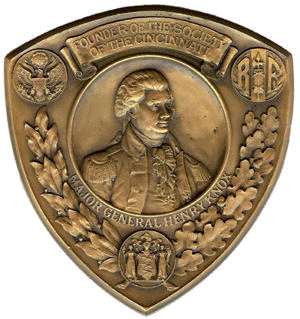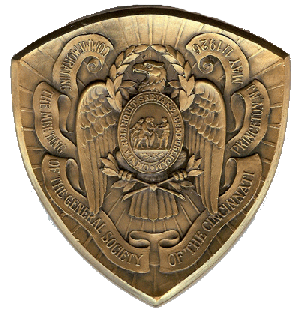The Society of the Cincinnati in the State of New Jersey was the host to the
General Society at Princeton, New Jersey, for the Triennial of 1926. As a
souvenir of this triennial, the second Triennial held at Princeton, the New
Jersey Society had made a medal of bronze (Hume #14), designed and struck by the
Department of Insignia of the Bailey, Banks and Biddle Company, of Philadelphia.
It is somewhat triangular in shape, the sides being slightly convex, each
measuring 3 inches.

Medal commemorating the meeting of the
General Society of the Cincinnati
at Princeton, New Jersey, 1926.
(Obverse). Hume #14.

Medal commemorating the meeting of the
General Society of the Cincinnati
at Princeton, New Jersey, 1926.
(Reverse). Hume #14.
70mm. Bronze.
The obverse bears a central disc 1-1/2 inches in diameter, in which appears the effigy of Major-General Henry Knox, facing slightly to the left. General Knox is wearing the uniform of his rank in the Continental Army and the Eagle of the Order of the Cincinnati. Just under the disc are the words: Major General Henry Knox. In the upper left angle of the medallion is a disc 1/2 inch in diameter bearing the arms of the United States, and in the upper right angle a similar disc bearing the arms of the French Republic. In the lower angle is a third disc with the arms of the State of New Jersey. At the top of the obverse is a scroll with the legend: Founder of the Society of the Cincinnati. Below the central disc are large branches of laurel leaves (left) and of oak leaves (right). The reverse of the medallion is charged with the Eagle of the Cincinnati, from which rays extend to the margins. About the Eagle is a flowing scroll bearing the legend: Commemorating the Meeting of the General Society of the Cincinnati Princeton, N. J. May 11, 1926. The medallion is 1/4 inch in thickness.
That General Knox, Washington's Chief of Artillery, should thus be honored as the founder of the Society of the Cincinnati is just. As early as 1776, as appears from an entry in Jefferson's diary (March 16, 1788), in a conversation with Adams, Knox expressed a "wish for some ribbon to wear in his hat or in his button-hole, to be transmitted to his descendants as a badge and proof that he fought in defense of their liberties. He spoke in such precise terms as showed that he had revolved it in his mind before."
The proposals for the establishment of the Cincinnati are in Knox's handwriting, and when the Institution was adopted on May 13, 1783, few changes were made in Knox's "proposals". He became the first Secretary General and was later Vice-President General of the Order and the original diplomas of the Revolutionary officers are all countersigned by him as Secretary General, being signed by George Washington as President General.
The medallion is open to criticism in that the arms of the French Republic are used instead of the arms of the Kingdom of France. This is historically inaccurate, since at the time of the institution of the Cincinnati the French Republic had not come into being, and moreover the King of France, Louis XVI, himself, did much to insure the success of the new Order in his Kingdom. He consented to become its Patron and permitted his officers to wear the Eagle, though no foreign decorations were then allowed in France, except the Golden Fleece. The King passed on the applications of his officers for the Eagle just as he did for the Royal and Military Order of Saint-Louis.
Last Page | Next Page | Return to First Page
© 2020 Sons of the Revolution in the State of California, Inc.
All Rights Reserved.
Legal & Privacy Notices
All Rights Reserved.
Legal & Privacy Notices
